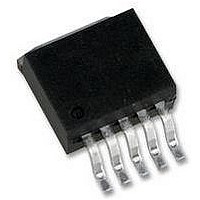LP3966ES-ADJ National Semiconductor, LP3966ES-ADJ Datasheet - Page 12

LP3966ES-ADJ
Manufacturer Part Number
LP3966ES-ADJ
Description
Linear Voltage Regulator IC
Manufacturer
National Semiconductor
Datasheets
1.LP3966ES-ADJ.pdf
(17 pages)
2.LP3966ES-ADJ.pdf
(14 pages)
3.LP3966ES-ADJ.pdf
(14 pages)
Specifications of LP3966ES-ADJ
No. Of Pins
5
Output Current
3A
Peak Reflow Compatible (260 C)
No
Termination Type
SMD
Current Rating
3000A
Output Voltage Max
5V
Leaded Process Compatible
No
Mounting Type
Through Hole
Lead Free Status / RoHS Status
Contains lead / RoHS non-compliant
Available stocks
Company
Part Number
Manufacturer
Quantity
Price
Company:
Part Number:
LP3966ES-ADJ
Manufacturer:
NS
Quantity:
1 553
Part Number:
LP3966ES-ADJ
Manufacturer:
NS/国半
Quantity:
20 000
www.national.com
Applications Information
Shutdown Operation
A CMOS Logic level signal at the shutdown ( SD) pin will
turn-off the regulator. Pin SD must be actively terminated
through a 10k pull-up resistor for a proper operation. If this
pin is driven from a source that actively pulls high and low
(such as a CMOS rail to rail comparator), the pull-up resistor
is not required. This pin must be tied to Vin if not used.
Dropout Voltage
The dropout voltage of a regulator is defined as the minimum
input-to-output differential required to stay within 2% of the
output voltage. The LP3963/LP3966 use an internal MOS-
FET with an Rds(on) of 240m (typically). For CMOS LDOs,
the dropout voltage is the product of the load current and the
Rds(on) of the internal MOSFET.
Reverse Current Path
The internal MOSFET in LP3963and LP3966 has an inher-
ent parasitic diode. During normal operation, the input volt-
age is higher than the output voltage and the parasitic diode
is reverse biased. However, if the output is pulled above the
input in an application, then current flows from the output to
the input as the parasitic diode gets forward biased. The out-
put can be pulled above the input as long as the current in
the parasitic diode is limited to 200mA continuous and 1A
peak.
Maximum Output Current Capability
LP3963 and LP3966 can deliver a continuous current of 3A
over the full operating temperature range. A heatsink may be
required depending on the maximum power dissipation and
maximum ambient temperature of the application. Under all
possible conditions, the junction temperature must be within
the range specified under operating conditions. The total
power dissipation of the device is given by:
P
where I
(specified under Electrical Characteristics).
The maximum allowable temperature rise (T
on the maximum ambient temperature (T
cation, and the maximum allowable junction temperature(T
max
T
The maximum allowable value for junction to ambient Ther-
mal Resistance,
LP3963 and LP3966 are available in TO-220 and TO-263
packages. The thermal resistance depends on amount of
copper area or heat sink, and on air flow. If the maximum al-
lowable value of
220 package and 60 ˚C/W for TO-263 package no heatsink
is needed since the package can dissipate enough heat to
satisfy these requirements. If the value for allowable
below these limits, a heat sink is required.
Heatsinking TO-220 Package
The thermal resistance of a TO220 package can be reduced
by attaching it to a heat sink or a copper plane on a PC
board. If a copper plane is to be used, the values of
be same as shown in next section for TO263 package.
The heatsink to be used in the application should have a
heatsink to ambient thermal resistance,
JA
Rmax
D
):
= (V
= T
= T
Rmax
GND
IN
−V
Jmax
OUT
is the operating ground current of the device
/ P
− T
D
)I
OUT
Amax
JA
JA
, can be calculated using the formula:
calculated above is
+ (V
IN
)I
GND
Amax
(Continued)
60 ˚C/W for TO-
Rmax
) of the appli-
) depends
JA
JA
falls
will
J -
12
In this equation,
tion to the surface of the heat sink and
sistance from the junction to the surface of the case.
about 3˚C/W for a TO220 package. The value for
pends on method of attachment, insulator, etc.
between 1.5˚C/W to 2.5˚C/W. If the exact value is unknown,
2˚C/W can be assumed.
Heatsinking TO-263 Package
The TO-263 package uses the copper plane on the PCB as
a heatsink. The tab of these packages are soldered to the
copper plane for heat sinking. Figure 3 shows a curve for the
a typical PCB with 1 ounce copper and no solder mask over
the copper area for heat sinking.
As shown in the figure, increasing the copper area beyond 1
square inch produces very little improvement. The minimum
value for
32˚C/W.
Figure 4 shows the maximum allowable power dissipation
for TO-263 packages for different ambient temperatures, as-
suming
ture is 125˚C.
HA
JA
FIGURE 3.
FIGURE 4. Maximum power dissipation vs ambient
of TO-263 package for different copper area sizes, using
JA
JA
−
JA
is 35˚C/W and the maximum junction tempera-
temperature for TO-263 package
CH
for the TO-263 packag mounted to a PCB is
JA
−
CH
vs Copper(1 Ounce) Area for TO-263
JC
is the thermal resistance from the junc-
.
package
JC
DS101267-32
is the thermal re-
DS101267-33
CH
CH
varies
JC
de-
is







